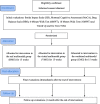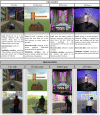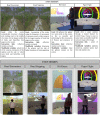A combination of multimodal physical exercises in real and virtual environments for individuals after chronic stroke: study protocol for a randomized controlled trial
- PMID: 31311595
- PMCID: PMC6636041
- DOI: 10.1186/s13063-019-3396-2
A combination of multimodal physical exercises in real and virtual environments for individuals after chronic stroke: study protocol for a randomized controlled trial
Abstract
Background: Multimodal physical exercises already have well-established benefits for the post-stroke population that influence gait functional capacity, balance, gait, cognition, and quality of life. This type of intervention can be performed in both real and virtual environments. Considering the characteristics of both environments, it is questioned to what extent the combination of interventions in real and virtual environments could result in improvement in post-stroke impairments.
Methods/design: We will conduct a randomized clinical trial with three groups: a real multimodal group (RMG), a virtual multimodal group (VMG), and a combined multimodal group (CMG). It was estimated that we will need a sample of 36 participants (12 per group). RMG individuals will only perform multimodal physical exercises in a real environment two times per week for 60 min per session for 15 weeks. VMG individuals will perform exercises of the same duration over the same time frame but only in a virtual environment. CMG individuals will hold a weekly session in a real environment and another weekly session in virtual environment. The primary outcome measure will be health-related quality of life, evaluated using the Stroke Impact Scale; effects on cognition (Montreal Cognitive Assessment), balance (Berg Balance Scale), mobility (Timed Up & Go), self-selected gait speed (10-meter walk test), and gait functional capacity (6-min walk test) will be investigated as secondary outcome measures. Participants will be evaluated before the beginning of the intervention, immediately after the end of the intervention, and at 1-month follow-up without exercise. If the data meet the assumptions of the parametric analysis, the results will be evaluated by analysis of variance (3 × 3) for the group factor, with repeated measures while taking into account the time factor. The post hoc Tukey test will be used to detect differences (α = 0.05).
Discussion: This study represents the first clinical trial to include three groups considering physical exercise in real and virtual environments, isolated and combined, that counterbalances the intensity and volume of training in all groups. This study also includes a control of progression in all groups along the 15-week intervention. The outcome measures are innovative because, according to International Classification of Functioning, Disability and Health, activity and participation are the targets for effectiveness evaluation.
Trial registration: Combinação de exercícios físicos multimodais em ambientes real e virtual para indivíduos pós acidente vascular cerebral crônico, RBR-4pt72m . Registered on 29 August 2016.
Keywords: Physical exercises; Quality of life.; Stroke; Virtual reality.
Conflict of interest statement
The authors declare that they have no competing interests.
Figures
Similar articles
-
Effects of inclined treadmill training on functional and cardiovascular parameters of stroke patients: study protocol for a randomized controlled trial.Trials. 2019 May 2;20(1):252. doi: 10.1186/s13063-019-3298-3. Trials. 2019. PMID: 31046812 Free PMC article.
-
Virtual reality gait training versus non-virtual reality gait training for improving participation in subacute stroke survivors: study protocol of the ViRTAS randomized controlled trial.Trials. 2019 Jan 29;20(1):89. doi: 10.1186/s13063-018-3165-7. Trials. 2019. PMID: 30696491 Free PMC article.
-
Erratum.Mult Scler. 2016 Oct;22(12):NP9-NP11. doi: 10.1177/1352458515585718. Epub 2015 Jun 3. Mult Scler. 2016. PMID: 26041800
-
High Intensity Exercise for Walking Competency in Individuals with Stroke: A Systematic Review and Meta-Analysis.J Stroke Cerebrovasc Dis. 2019 Dec;28(12):104414. doi: 10.1016/j.jstrokecerebrovasdis.2019.104414. Epub 2019 Sep 27. J Stroke Cerebrovasc Dis. 2019. PMID: 31570262
-
[Effects of virtual reality on balance and gait in stroke: a systematic review and meta-analysis].Rev Neurol. 2019 Sep 16;69(6):223-234. doi: 10.33588/rn.6906.2019063. Rev Neurol. 2019. PMID: 31497866 Spanish.
Cited by
-
Rehabilitation in Older Adults Affected by Immobility Syndrome, Aided by Virtual Reality Technology: A Narrative Review.J Clin Med. 2023 Aug 31;12(17):5675. doi: 10.3390/jcm12175675. J Clin Med. 2023. PMID: 37685741 Free PMC article. Review.
-
Immersive Virtual Reality in Stroke Patients as a New Approach for Reducing Postural Disabilities and Falls Risk: A Case Series.Brain Sci. 2020 May 15;10(5):296. doi: 10.3390/brainsci10050296. Brain Sci. 2020. PMID: 32429085 Free PMC article.
References
-
- Gordon NF, Gulanick M, Costa F, Fletcher G, Franklin BA, Roth EJ, et al. Physical activity and exercise recommendations for stroke survivors: an American Heart Association scientific statement from the Council on Clinical Cardiology, Subcommittee on Exercise, Cardiac Rehabilitation, and Prevention; the Council on Cardiovascular Nursing; the Council on Nutrition, Physical Activity, and Metabolism; and the Stroke Council. Circulation. 2004;109(16):2031–2041. doi: 10.1161/01.CIR.0000126280.65777.A4. - DOI - PubMed
-
- Saltychev M, Sjögren T, Bärlund E, Laimi K, Paltamaa J. Do aerobic exercises really improve aerobic capacity of stroke survivors? A systematic review and meta-analysis. Eur J Phys Rehabil Med. 2016;52(2):233–243. - PubMed
-
- Lee NK, Kwon JW, Son SM, Kang KW, Kim K, Hyun-Nam S. The effects of closed and open kinetic chain exercises on lower limb muscle activity and balance in stroke survivors. NeuroRehabilitation. 2013;33(1):177–83. - PubMed
-
- Shin WS, Lee SW, Lee YW, Choi SB, Song CH. Effects of combined exercise training on balance of hemiplegic stroke patients. J Phys Ther Sci. 2011;23(4):639–643. doi: 10.1589/jpts.23.639. - DOI
Publication types
MeSH terms
LinkOut - more resources
Full Text Sources
Medical




